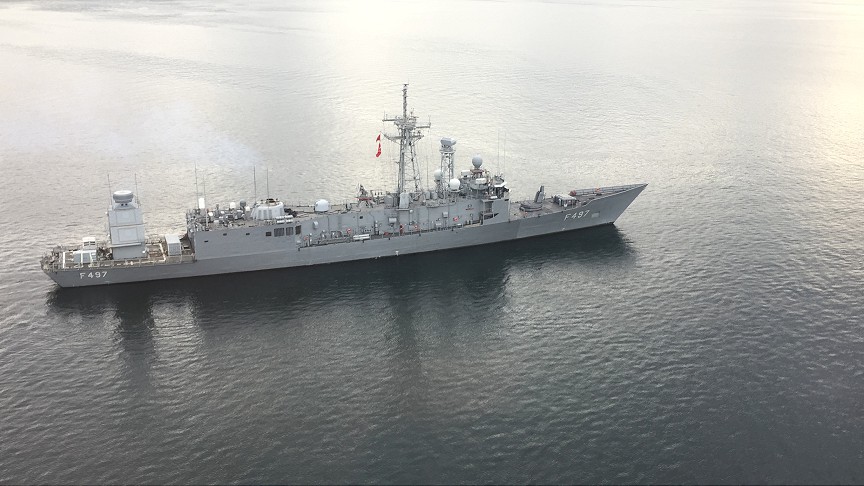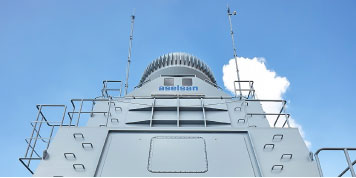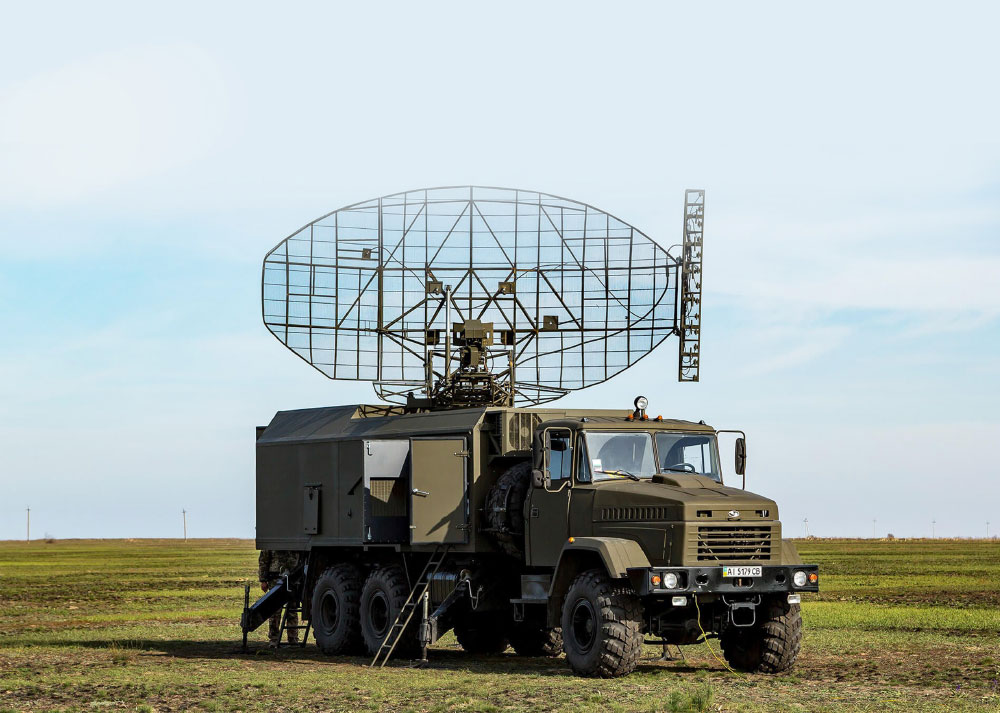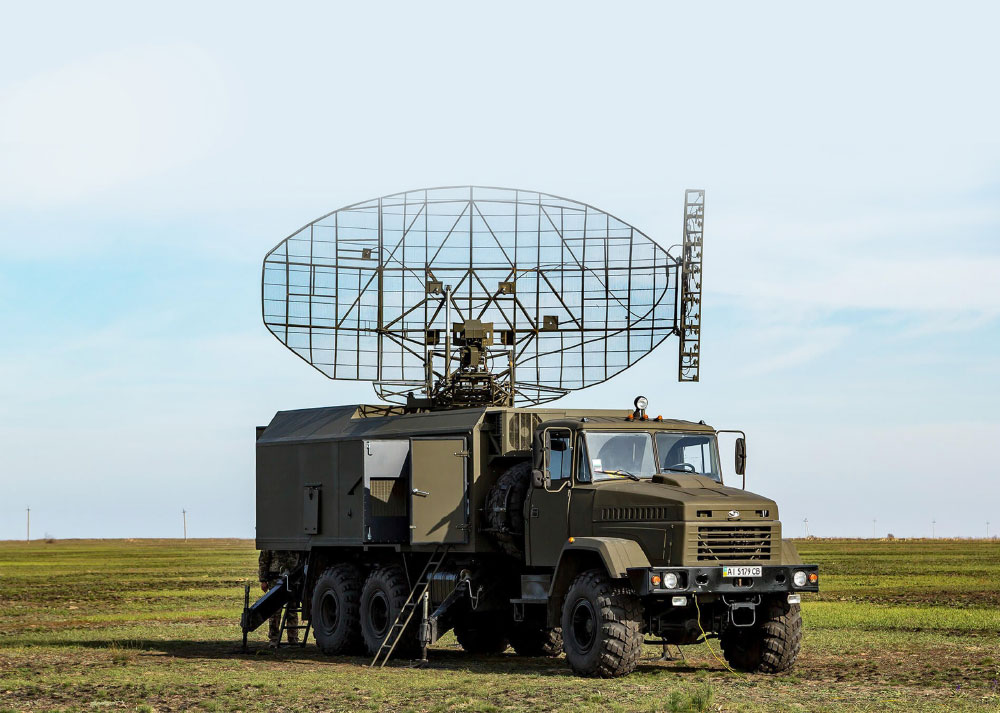At the 9th Naval Systems Seminar, which was held on October 14-15, 2019, with the support of the Turkish Presidency of Defense Industries, Turkish Naval Forces, ODTÜ-BİLTİR, TSS News Group, and AFCEA-TR, at Middle East Technical University (METU) Culture and Convention Center, valuable information about the Multi-Functional Phased Array Radar (ÇAFRAD) and the Network Enabled Data Integrated (ADVENT) Combat Management System was shared with seminar participants.

Speaking at the seminar, Turkish Naval Forces Naval Technical Commander Rear Admiral (Lower Half) Dr. Ramis AKIN shared information saying “Together with Aselsan, we have installed the system to the Tuzla Naval Electronic Warfare Test and Training Field of the Turkish Naval Research Center Command (ARMERKOM/TNRCC). We use the prototype system there. We are continuing our efforts to make the final ÇAFRAD System ready for the TF-2000 Air Defense Warfare (ADW) Destroyer as soon as possible.”
Aselsan Naval Platform Radars Project Manager Dr. Kıvanç İNAN made a presentation titled Multi-Functional Digital Radar Architecture and the ÇAFRAD Solution for Air Defense Warfare Platform on October 14th. In his speech, İNAN stated that digital radars are one of the most critical requirements of today and noted that Aselsan applies all the digital radar technologies such as electronic beam steering active antenna design and Gallium-Arsenite (GaAs) & Gallium-Nitrate (GaN) transmit/receive (T/R) modules in both ÇAFRAD and all of their new generation radars. “We have applied the Gallium-Arsenite (GaAs) in ÇAFRAD Phase-1, and we are switching to Gallium-Nitrate (GaN) in Phase-2. Thanks to our partnership with AB-MikroNano, it will be possible to localize all these Gallium-Nitrate (GaN) transmit/receive (T/R) modules in Phase-2 and on-going radar projects. When we look at digital waveform design, production, and testing, both ÇAFRAD and all of our new generation radars generate digital waveforms.”
Continuing his speech, İNAN also said: “ÇAFRAD is a Multi-Functional Phased Array Radar. What we mean with Multi-Functional is that all activities under the Air Defense Warfare (ADW) and Anti-Surface Warfare (ASuW) are carried out simultaneously. In other words, ÇAFRAD can perform volume search, horizon line search, precise target tracking, fire control, target illumination, guidance data link, target classification, and coordinated Air Defense Warfare and Anti-Surface Warfare. It also provides an Inverse Synthetic Aperture (ISAR) range profile, operational support, precision approach (PAR) support to helicopters and UAVs, and Command Control (C2) support. The radar optimally performs all these activities and prioritizes these tasks with intelligent resource management planning.”
Noting that all the capabilities of ÇAFRAD are performed simultaneously, İNAN emphasized that ÇAFRAD is capable of electronically scanning the whole space not horizontally but also vertically. “It has an Active Electronically Scanned Array (AESA) architecture. We use thousands of Transmit/Receive (T/R) modules. The acquired data is digitized and then downloaded at the Gigabit level. All the technologies used in the system, especially the ÇAFRAD Phase-1, are of domestic design. In Phase-2, many of these technologies will also be produced domestically.”
İNAN stated that the ÇAFRAD System consists of 4 radars, namely Multi-Function Radar (ÇFR), Illumination Radar (AYR), Long Range Radar (UMR) and IFF System and pointed out that the ÇFR, which has a 400-to-360 degree coverage, functions as the brain of the ÇAFRAD system at close range. “It works in X-Band and can perform all the functions such as volume search, horizon line search, air and surface targets detection, tracking and classification, multi-precision target tracking simultaneously. ÇFR has a range of 150km, and it serves as a fire control radar at close range. ÇFR consists of more than 1,000 modules which can continue to operate even if the antenna elements are damaged. When we look at the AYR, we can say that it is not a radar but an illuminator. This unit provides data link capability to the guided missiles and can illuminate multiple targets simultaneously. On the other hand, the S-Band UMR is the long-range version of the ÇFR and performs all the functions of ÇFR at long range. It can be considered as the long-range version of the ÇFR with a range of approximately 450km. In general, the UMR detects the target at long range then transmits this information to the ÇFR, which engages against it at close range. Finally, we have the non-rotating IFF antenna system with a range of more than 450km. It works together with the UMR. It supports all modes including, Mode 1, 2, 3, 4, C, S, and 5. This long-range IFF system is integrated with the long-range identifier developed by Aselsan and is currently undergoing testing.”
In his speech İNAN also informed the participants about the on-going Phase-1 tests. “In Phase-1, the scaled version of the MFR and the scaled version of the UMR and the final IFF system were produced. The project started in September 2013 and was completed as of December 2018. In this context, the system has been verified up to all sub-components in Phase-1, Phase-2 will only cover the serial production. As the system used in Phase-1 is a slightly scaled model of the final ÇAFRAD system, some of its capabilities are also reduced and scaled. In fact, the only difference is that its range is a bit shorter than the final ÇFR system. The scaled model has less processing capacity for tracking and signal processing because the software and algorithms used in the scaled model are not the final versions. Apart from that, all of the features are exactly the same as the final ÇAFRAD system. The UMR was not tested in Phase-1, because the UMR is the Naval version of the Early Warning Radar System EIRS project that is already being tested. The reason for using the container structure in ÇAFRAD Phase-1 was that we could first test the system in Gölbaşı Ankara thanks to the containers and then we placed this modular structure on the helicopter deck of the TCG Göksu Frigate. As part of the platform integration process, approximately 80 tons of testing equipment was placed on the deck of the ship, and various tests were performed with the system. Before the cruise tests, we didn't make any alterations to the ship's Combat Management System (CMS); instead, we installed a separate mini CMS on the ship. This mini CMS operated in conjunction with the ship's main CMS, and it was connected to the guided-missile infrastructure on the ship. Thus, the ÇAFRAD system operated synchronously with the whole ship. The indigenous high-speed Şimşek drone developed by TUSAŞ was used in the guided missile (RIM-162B Block 1 Evolved SeaSparrow Missile/ESSM) test performed in Sinop on December 11, 2018. During the test, ÇFR first detected and tracked the Şimşek drone then engaged it with a Guided Missile at a specified range. The ESSM guided missile successfully hit the target at the desired range, which was the longest range ever tested. We tested the system with F-16s, helicopters, naval vessels. Finally, the system was installed at Tuzla Naval Academy. The system is located in an area with intense air and sea traffic. Optimization of the system is carried out there by Aselsan with the participation of the Naval Research Center Command (ARMERKOM/TNRCC) officials. Various activities planned for ÇAFRAD Phase-2 will also be tested at Tuzla.”

Speaking at the seminar, Turkish Naval Forces Naval Technical Commander Rear Admiral (Lower Half) Dr. Ramis AKIN shared information saying “Together with Aselsan, we have installed the system to the Tuzla Naval Electronic Warfare Test and Training Field of the Turkish Naval Research Center Command (ARMERKOM/TNRCC). We use the prototype system there. We are continuing our efforts to make the final ÇAFRAD System ready for the TF-2000 Air Defense Warfare (ADW) Destroyer as soon as possible.”
Aselsan Naval Platform Radars Project Manager Dr. Kıvanç İNAN made a presentation titled Multi-Functional Digital Radar Architecture and the ÇAFRAD Solution for Air Defense Warfare Platform on October 14th. In his speech, İNAN stated that digital radars are one of the most critical requirements of today and noted that Aselsan applies all the digital radar technologies such as electronic beam steering active antenna design and Gallium-Arsenite (GaAs) & Gallium-Nitrate (GaN) transmit/receive (T/R) modules in both ÇAFRAD and all of their new generation radars. “We have applied the Gallium-Arsenite (GaAs) in ÇAFRAD Phase-1, and we are switching to Gallium-Nitrate (GaN) in Phase-2. Thanks to our partnership with AB-MikroNano, it will be possible to localize all these Gallium-Nitrate (GaN) transmit/receive (T/R) modules in Phase-2 and on-going radar projects. When we look at digital waveform design, production, and testing, both ÇAFRAD and all of our new generation radars generate digital waveforms.”
Continuing his speech, İNAN also said: “ÇAFRAD is a Multi-Functional Phased Array Radar. What we mean with Multi-Functional is that all activities under the Air Defense Warfare (ADW) and Anti-Surface Warfare (ASuW) are carried out simultaneously. In other words, ÇAFRAD can perform volume search, horizon line search, precise target tracking, fire control, target illumination, guidance data link, target classification, and coordinated Air Defense Warfare and Anti-Surface Warfare. It also provides an Inverse Synthetic Aperture (ISAR) range profile, operational support, precision approach (PAR) support to helicopters and UAVs, and Command Control (C2) support. The radar optimally performs all these activities and prioritizes these tasks with intelligent resource management planning.”
Noting that all the capabilities of ÇAFRAD are performed simultaneously, İNAN emphasized that ÇAFRAD is capable of electronically scanning the whole space not horizontally but also vertically. “It has an Active Electronically Scanned Array (AESA) architecture. We use thousands of Transmit/Receive (T/R) modules. The acquired data is digitized and then downloaded at the Gigabit level. All the technologies used in the system, especially the ÇAFRAD Phase-1, are of domestic design. In Phase-2, many of these technologies will also be produced domestically.”
İNAN stated that the ÇAFRAD System consists of 4 radars, namely Multi-Function Radar (ÇFR), Illumination Radar (AYR), Long Range Radar (UMR) and IFF System and pointed out that the ÇFR, which has a 400-to-360 degree coverage, functions as the brain of the ÇAFRAD system at close range. “It works in X-Band and can perform all the functions such as volume search, horizon line search, air and surface targets detection, tracking and classification, multi-precision target tracking simultaneously. ÇFR has a range of 150km, and it serves as a fire control radar at close range. ÇFR consists of more than 1,000 modules which can continue to operate even if the antenna elements are damaged. When we look at the AYR, we can say that it is not a radar but an illuminator. This unit provides data link capability to the guided missiles and can illuminate multiple targets simultaneously. On the other hand, the S-Band UMR is the long-range version of the ÇFR and performs all the functions of ÇFR at long range. It can be considered as the long-range version of the ÇFR with a range of approximately 450km. In general, the UMR detects the target at long range then transmits this information to the ÇFR, which engages against it at close range. Finally, we have the non-rotating IFF antenna system with a range of more than 450km. It works together with the UMR. It supports all modes including, Mode 1, 2, 3, 4, C, S, and 5. This long-range IFF system is integrated with the long-range identifier developed by Aselsan and is currently undergoing testing.”
In his speech İNAN also informed the participants about the on-going Phase-1 tests. “In Phase-1, the scaled version of the MFR and the scaled version of the UMR and the final IFF system were produced. The project started in September 2013 and was completed as of December 2018. In this context, the system has been verified up to all sub-components in Phase-1, Phase-2 will only cover the serial production. As the system used in Phase-1 is a slightly scaled model of the final ÇAFRAD system, some of its capabilities are also reduced and scaled. In fact, the only difference is that its range is a bit shorter than the final ÇFR system. The scaled model has less processing capacity for tracking and signal processing because the software and algorithms used in the scaled model are not the final versions. Apart from that, all of the features are exactly the same as the final ÇAFRAD system. The UMR was not tested in Phase-1, because the UMR is the Naval version of the Early Warning Radar System EIRS project that is already being tested. The reason for using the container structure in ÇAFRAD Phase-1 was that we could first test the system in Gölbaşı Ankara thanks to the containers and then we placed this modular structure on the helicopter deck of the TCG Göksu Frigate. As part of the platform integration process, approximately 80 tons of testing equipment was placed on the deck of the ship, and various tests were performed with the system. Before the cruise tests, we didn't make any alterations to the ship's Combat Management System (CMS); instead, we installed a separate mini CMS on the ship. This mini CMS operated in conjunction with the ship's main CMS, and it was connected to the guided-missile infrastructure on the ship. Thus, the ÇAFRAD system operated synchronously with the whole ship. The indigenous high-speed Şimşek drone developed by TUSAŞ was used in the guided missile (RIM-162B Block 1 Evolved SeaSparrow Missile/ESSM) test performed in Sinop on December 11, 2018. During the test, ÇFR first detected and tracked the Şimşek drone then engaged it with a Guided Missile at a specified range. The ESSM guided missile successfully hit the target at the desired range, which was the longest range ever tested. We tested the system with F-16s, helicopters, naval vessels. Finally, the system was installed at Tuzla Naval Academy. The system is located in an area with intense air and sea traffic. Optimization of the system is carried out there by Aselsan with the participation of the Naval Research Center Command (ARMERKOM/TNRCC) officials. Various activities planned for ÇAFRAD Phase-2 will also be tested at Tuzla.”











